

 |
 |
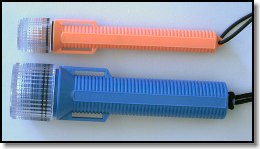 Tektite, known for its dive and industrial flashlights,
makes a diverse and growing number of LED flashlights.� C. Crane Company has exclusive consumer
marketing rights for most of the LED line, but not all. There is only one major
functional difference between the Tektite branded lights and the consumer
versions.� The former are rated to 1000
ft., the latter only to 10 ft. by Tektite, though C. Crane claims 160 ft. for
the black-bodied lights based on their own tests, the difference being in the
o-ring seals for the head. The �dive� series offered by C. Crane are the
Tektite version with the dive rated o-ring seals.
Tektite, known for its dive and industrial flashlights,
makes a diverse and growing number of LED flashlights.� C. Crane Company has exclusive consumer
marketing rights for most of the LED line, but not all. There is only one major
functional difference between the Tektite branded lights and the consumer
versions.� The former are rated to 1000
ft., the latter only to 10 ft. by Tektite, though C. Crane claims 160 ft. for
the black-bodied lights based on their own tests, the difference being in the
o-ring seals for the head. The �dive� series offered by C. Crane are the
Tektite version with the dive rated o-ring seals.
At this juncture there are two lines, �Trek� and
�Expedition,� the former based on small bodies using AA-cell batteries or
smaller, the latter on a triple C-cell body.�
Tektite offers bodies in Black, Orange, Yellow and Blue ABS plastic. �C. Crane offers theirs in black ABS and also
in red, yellow and blue translucent I-Mac colors made of Lexan brand
polycarbonate.
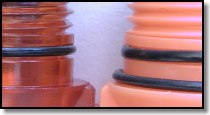 The Trek 2 ($35) (CC Trek Light from C.Crane ($30)) and Trek
4 ($45), two and four LEDs respectively, are powered by a trio of AA-cell
alkaline batteries. The conventionally shaped body, 7 1/4 x 1 1/4, 4 oz., has
ringed ridges that run from the base to the head, providing a very secure
grip.� A protruding tab on the base is
equipped with a hole through which is permanently threaded a 10-inch elastic
lanyard that works very well. Slotted side pieces below the head allow you to
strap it to something and also prevent it from rolling.
The Trek 2 ($35) (CC Trek Light from C.Crane ($30)) and Trek
4 ($45), two and four LEDs respectively, are powered by a trio of AA-cell
alkaline batteries. The conventionally shaped body, 7 1/4 x 1 1/4, 4 oz., has
ringed ridges that run from the base to the head, providing a very secure
grip.� A protruding tab on the base is
equipped with a hole through which is permanently threaded a 10-inch elastic
lanyard that works very well. Slotted side pieces below the head allow you to
strap it to something and also prevent it from rolling.
The lens cum rotary switch is clear Lexan brand polycarbonate. It had longitudinal ridges for a good grip. As a result of the difference in o-rings the consumer versions are quite a bit easier to switch on and off since the head turns easier. The latter can be switched on one handed, the dive versions cannot, unless you're a gorilla. While many didn't find the dive versions objectionable in this regard, some testers complained and preferred the consumer versions.� For most purposes, unless extreme waterproof capability is necessary, the easier to operate consumer versions from C. Crane will be a better choice.
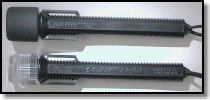 Tektite includes a black rubber shroud that slips over the
head to block light emissions from the sides, which can be annoying at
times.� The interior has four tabs that
catch the ridges in the head to keep it from slipping and the exterior is
textured for better grip. C. Crane includes that shroud in an Accessory Kit
($20) including also a red lens, elastic headband, magnetic mounting clip and a
belt clip.
Tektite includes a black rubber shroud that slips over the
head to block light emissions from the sides, which can be annoying at
times.� The interior has four tabs that
catch the ridges in the head to keep it from slipping and the exterior is
textured for better grip. C. Crane includes that shroud in an Accessory Kit
($20) including also a red lens, elastic headband, magnetic mounting clip and a
belt clip.
The Trek 2 ran for nearly 50 hours on a set of batteries. The 4-LED model didn't appear to be twice as bright as the 2-LED model, but it was quite a bit brighter. The LEDs converge to form an moderately diffuse beam.� We got 38 hours from the Trek 4.
All these Trek lights are adequately bright for close-up work or illuminating your way.
Lithium AA-cells can be used for better cold weather operation and longer life, as well as providing slightly brighter illumination as they are 1.6 to 1.7 volts compared to 1.5 for the alaklines.
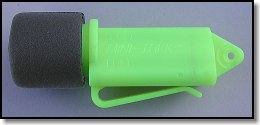 The Mini-Trek Light ($35) takes a trio of AAA-cell batteries
powering a pair of LEDs, same as its big brother Trek 2. The case holds the
three batteries in a stacked triangular configuration.� That makes for a compact body, 4 x 1 1/2
in., 2.5 oz., but also makes it difficult to change out the batteries.� It's a complicated procedure that takes a
page of instructions to describe and requires a pen or similar instrument to
manipulate the batteries into position. It's not something you'd want to
attempt in the dark.
The Mini-Trek Light ($35) takes a trio of AAA-cell batteries
powering a pair of LEDs, same as its big brother Trek 2. The case holds the
three batteries in a stacked triangular configuration.� That makes for a compact body, 4 x 1 1/2
in., 2.5 oz., but also makes it difficult to change out the batteries.� It's a complicated procedure that takes a
page of instructions to describe and requires a pen or similar instrument to
manipulate the batteries into position. It's not something you'd want to
attempt in the dark.
The light is available with either black or yellow body
only. Alone among this group, the rubber shroud is included also on the C.
Crane version. A molded-in clip allows you to clip it to a hat brim and it has
an enlarged "bite" area for the lanyard tab with integrated ridges,
both of which allow for hands-off use, a handy feature.
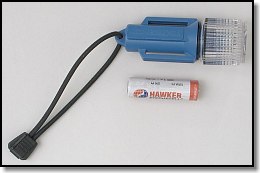 The bit more compact �Lithium Trek Light� ($35), 3 1/2 x 1
1/4 in., 1.7 oz., uses a single special 3.6-volt lithium battery (size of a
AA-cell) which is both expensive ($11) and not easily found (Radio Shack or
order off the Web). The lithium-powered light is equipped with three LEDs, but
is still noticeably dimmer than the others--voltage, or more precisely, lack
thereof, makes the difference.� On the
other hand, battery life was an impressive 46 hours in our test.� An elastic lanyard is fitted.
The bit more compact �Lithium Trek Light� ($35), 3 1/2 x 1
1/4 in., 1.7 oz., uses a single special 3.6-volt lithium battery (size of a
AA-cell) which is both expensive ($11) and not easily found (Radio Shack or
order off the Web). The lithium-powered light is equipped with three LEDs, but
is still noticeably dimmer than the others--voltage, or more precisely, lack
thereof, makes the difference.� On the
other hand, battery life was an impressive 46 hours in our test.� An elastic lanyard is fitted.
The compact size combined with long battery life and long
shelf life makes it a good choice for survival kit storage.� Given the high cost of the battery and
relative dimness of the light, it wouldn't be our first choice for everyday use.
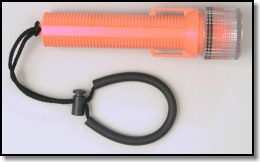 The Expedition line is all powered by three alkaline
C-cells.� The body is just a bulked up
version of the smaller three AA-cell lights with the same features, except 7
3/4 inches long (include lanyard hole) by 1 1/4 inch in diameter with a 2-inch
diameter head.� Weight is 11 oz. C.
Crane offers an Accessory Kit for the Expedition line ($20) that includes a red
lens cap, belt holster and wall mounting clip.
The Expedition line is all powered by three alkaline
C-cells.� The body is just a bulked up
version of the smaller three AA-cell lights with the same features, except 7
3/4 inches long (include lanyard hole) by 1 1/4 inch in diameter with a 2-inch
diameter head.� Weight is 11 oz. C.
Crane offers an Accessory Kit for the Expedition line ($20) that includes a red
lens cap, belt holster and wall mounting clip.
Replacing the short elastic lanyard is one of the nicest lanyards we've seen, though unfortunately the lanyard hole is too small to allow it to be easily removed or reinstalled as desired (After discussion with the manufacturer, I learned that the trick is to use a paper clip bent into a small �hook� to pull it through the hole, which does work, but a larger hole would be better.). The 18 in. line is equipped with a cord lock so it can be adjusted to keep it from slipping off your wrist and an 8 in. section of very pliable, soft rubber tubing as a wrist chafe guard, adding a considerable measure of comfort.
The batteries are a very loose fit inside the tubular body.� That makes changing them out easy, they fall right out, but it also results in an annoying rattle in many cases. A simple solution was to slip a piece of thin cardboard down one side.� Encasing the batteries in a short section of shrink tubing also worked, but that's hardly practical for most people. Tektite tells us that they have a new stiffer spring that has already entered production, which will help considerably.�
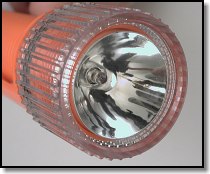 The Expedition 50 (CCXtreme from C.Crane) has a single white
LED.� It is unique among all LED
flashlights in being focusable. Twisting the head in and out changes the focus,
moving a reflector in and out.� While
this isn't nearly as effective as with a bright incandescent bulb, it proved
useful.�
The Expedition 50 (CCXtreme from C.Crane) has a single white
LED.� It is unique among all LED
flashlights in being focusable. Twisting the head in and out changes the focus,
moving a reflector in and out.� While
this isn't nearly as effective as with a bright incandescent bulb, it proved
useful.�
The 4.5 volts doesn't give quite as bright a light as the
single LED lights powered by 6 volts, but it is adequately bright for most
survival use.� Since you can focus the
light for a tighter beam at some distance away instead of the typical flood of
light from a conventional LED light, this compensates for the lesser
brightness.� This light's other big
claim to fame is that it is rated at 200 hours at full brightness, plus
hundreds more at lower illumination levels.
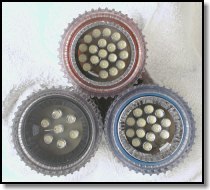 The other lights in the Expedition line are all identical
except for the number of white LEDs used: 7, 14 and 19; models Expedition 300
($70), Expedition 1400 ($120), and Expedition 1900 ($150) respectively. More
than most, these lights illustrate the fact that white LEDs are still pretty
dear commodities.� Battery life pretty
much equals the manufacturer's ratings of 40, 20 and 10 hours,
respectively.� Expect again as long life
or more at reduced brightness levels.�
The other lights in the Expedition line are all identical
except for the number of white LEDs used: 7, 14 and 19; models Expedition 300
($70), Expedition 1400 ($120), and Expedition 1900 ($150) respectively. More
than most, these lights illustrate the fact that white LEDs are still pretty
dear commodities.� Battery life pretty
much equals the manufacturer's ratings of 40, 20 and 10 hours,
respectively.� Expect again as long life
or more at reduced brightness levels.�
Obviously you trade off battery life for brightness, and these lights are, indeed, bright. More so than any of the other LED flashlights we have tested, these Expedition lights most easily stand in for a conventional high-powered light for all but the most extreme long distance lighting needs.� They still won't reach out and illuminate something a mile or more away, but they are quite adequate out to a couple hundred feet or so for the 19 LED model.� The LEDs combine to produce a decent sized central area of bright, even lighting that is easy to work with.
The U.S. Navy approved a militarized version (which is functionally the same) of the seven LED light. While not inexpensive, nothing else comes close to combining the light output with long battery life.� The size is not objectionable for a �standard� flashlight, the form factor is practical and C-cells are extremely inexpensive and widely available.
Tektite lights are made in the U.S. and come with a limited lifetime warranty.
For more information, check Craig Johnson's LED Museum
| LED Flashlight Review (click to continue to next page) |
|
| SELECT AND USE OUTDOORS AND SURVIVAL EQUIPMENT, SUPPLIES AND TECHNIQUES AT YOUR OWN RISK. Please review the full WARNING & DISCLAIMER about information on this site. |
Publisher and Editor: Doug Ritter
Email: Doug Ritter
URL:
http://www.equipped.org/led_lights6.htm
First Published: June 7, 2001
![]()
Email to: [email protected]
|
© 2001 Douglas S. Ritter & Equipped To Survive Foundation, Inc. All rights reserved. Check our Copyright Information page for additional information. |
Read the ETS Privacy Policy |